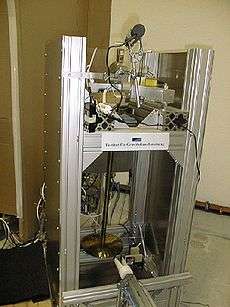Paraconical pendulum
Paraconical pendulum
Maurice Allais, a French researcher, invented the paraconical pendulum around 1950, and during the 1950s he conducted six marathon series of long-term observations, during each of which his team manually operated and manually monitored his pendulum non-stop over about a month. The objective was to investigate possible changes over time of the characteristics of the motion, hypothesized to yield information about asymmetries of inertial space (sometimes described as "aether flow").

Characterization and experiments
The defining feature of the "paraconical" or "ball-borne" pendulum is that the pendulum is carried upon a ball which rests upon a flat, thus permitting it to rotate about its vertical axis as well as swinging in two perpendicular directions. Therefore a paraconical pendulum has three degrees of freedom. When the rotation of the Earth is taken into account, the formal equations in classical mechanics of the behavior of this dynamical system are rather complex. The rolling friction of the ball upon the flat is extremely low, so that a paraconical pendulum has a high Q factor, principally determined by air resistance. Typically a paraconical pendulum is built as a solid body with a stiff rod, rather than with a flexible wire or cord, and its length is usually about one meter. If an accurately spherical ball and an accurately planar flat are used, a paraconical pendulum is a highly sensitive instrument: as first noted by Allais, and now confirmed by modern researchers, its motion exhibits a 24.8 hour cyclic pattern, presumably a manifestation of lunar influence.
External links
- Göde Wissenschafts Stiftung Website: Description of recent experiments with a modern automated paraconical pendulum.
- Video of another modern automatic paraconical pendulum.
- Maurice Allais, Ten Notes published (in French) in the Proceedings of the French Academy of Sciences (Comptes Rendus des Seances de l'Academie des Sciences), dated 4/11/57, 13/11/57, 18/11/57, 13/5/57, 4/12/57, 25/11/57, 3/11/58, 22/12/58, 9/2/59, and 19/1/59, some translated into English.
- Pictures of the original paraconical pendulum, built by Maurice Allais in France in the 1950s, which was manually operated and observed by eye.
See also
- Allais effect - about a claim asserted by Maurice Allais of anomalous behavior of his pendulum during a partial solar eclipse in 1954.